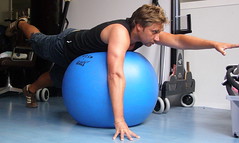
Controversial title there.....
If you ever train in a "health club" or a commercial gym ,you will have seen people training on stability balls or swiss balls as they are sometimes known. The argument is that by training on one of these you are helping your core muscles. The ball becomes an unstable base and to keep your body stable you are forced to use lots of small stabilising muscles.
Now I am a fan of functional training. The body moves in three dimensions and I think it is important to train the body through movements in each of those planes.
I've also written about the benefits of balance training in preventing injuries to the knee and ankle. I must admit, that I have also previously accepted as axiomatic the basic argument for Swiss ball training put forward by people like the great Paul Chek.
Having just come across a new study I am having to revisit my assumptions about this approach.
This study seems to indicate that the assumptions that
performing an exercise on an unstable surface causes “the little muscles to work harder to stabilize the joints.”
and that
the mere addition of unstable surfaces to simple tasks (e.g. sitting on an exercise) ball transforms these simple tasks into exercises which stress the “core” musculature (trunk and pelvis muscles)"
are not necessarily true in every case for every individual.
The full text of the study is available here, but the conclusion is very interesting and challenging to the current orthodoxy:
Conclusion and clinical relevance. The examples presented here and the findings from the literature suggest that the mere addition of a labile (unstable) surface is not a sufficient condition to achieve increases in muscle activity for all muscles and for all individuals. Individuals can present markedly varied responses and can respond in a manner significantly different from the mean. This is relevant to the rehabilitation professional when designing conditioning programs that attempt to create overload conditions over time. Merely adding labile surfaces may not increase the load on the neuromuscular system for specific patients. An argument can even be made that adding Swiss balls to certain exercises (wall squats14 and spine extensor exercises7) decreases the stress on the musculature due to decreases in muscle activation following the incorporation of a Swiss ball.
I am not saying not to use a swiss ball. However, the key issue here - as ever - is to think for yourself. There is a lot of dogma out there in the strength and conditioning field. But just because everyone is doing it or teaching it doesn't mean that it will be effective for you. ON average it might help, but you might not be average.
My take on functional training also relies on mimicking and training the movements of everyday life. Thinking about it I cannot think of many movements in normal life where you'd be sat on or leaning on an unstable surface. It is not the same as being on one leg, or walking on rough ground. The swiss ball is not a "natural" base. It doesn't - in my opinion - train a position or movement that will help you in sports or normal life.
Controversial? What do you think?

3 comments:
Eric Cressey (best known for his articles on T-nation) did his masters thesis on unstable surface training. Does NOT have good things to say about it in terms of training for healthy athletes.
Link to abstract:
http://apt.allenpress.com/perlserv/?request=get-abstract&issn=1533-4287&volume=021&issue=02&page=0561
Thanks for the link that is interesting stuff. I like Eric's writing's and often read his blog. Thanks for the comment
Chris
this kind of blog always useful for blog readers, it helps people during research. your post is one of the same for blog readers.
Post a Comment